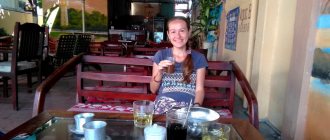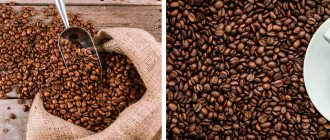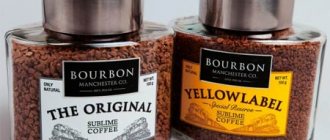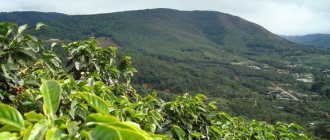Ethiopia is considered to be the birthplace of coffee. However, the people of Yemen were the first to cultivate and grow this plant. There is still debate about whether the first Yemeni coffee plantations first appeared in the 12th or 14th century.
Yemeni coffee is rare and therefore very expensive, but the cost is justified by its high quality. He is still considered one of the best in the world.
The most popular varieties in the world
Australian
The most popular is Arabica Australia Skyberry. This variety appeared in the world relatively recently, but has already won the love of gourmets all over the world, because its qualities are in many ways reminiscent of the favorite, expensive drink of the British royal family - Jamaican Blue Mountain. Taste characteristics – soft taste with a tart note.
Asiatic
- Arabica Yemen Mocha Mattari. For many centuries, the real wealth of Yemen was considered to be spices, incense and a special type of coffee - mattari mocha. The name of the product comes from the area where the plants are grown. It was this variety that first appeared on the territory of Russia and European monarchs drank it with pleasure, for which the drink began to be called “coffee of the lords.” Mocha has unique taste qualities - it can be easily recognized by its light sourness and pleasant chocolate aftertaste. This is one of the most popular single-origin coffees.
- Robusta India Cherry. This variety of Robusta has an incredibly rich aroma and a rather bitter taste with a slight sourness. It is not used as a single variety, but is often added to coffee blends.
Note: the following varieties are very popular - Arabica India Monsund Malabar, the most expensive coffee is recognized as Arabica Indonesia Kopi Luwak, another variation of the famous Blue Mountain - Arabica Papua New Guinea RV.
Arabica South America
- Brazil Santos (Arabica Brazil Santos). The drink has a rich, rather strong taste with a slight sourness and a hint of spice. If you don’t like exotic coffee, but prefer classic coffee, choose this variety.
- Colombia Supremo. The name means magnificent. The drink fully justifies its title - delicate, velvety taste, slightly sweet with a slight wine sourness.
Central America
- Arabica Guatemala Maragogype. It has a spicy taste and a slightly smoky aroma. The drink is valued for its richness and rich flavor bouquet with floral and fruity notes.
- Arabica Guatemala Antigua. It is distinguished by characteristic bitterness and notes of prunes, the aftertaste is light, citrusy with spicy chocolate notes. This variety is chosen by gourmets from different continents.
African
The most popular Arabica varieties are:
- Burundi AA (Arabica Burundi AA);
- Kenya (Arabica Kenya);
- Ethiopia Sidamo (Arabica Ethiopia Sidamo).
Considering that coffee is grown on many continents, we can say with confidence that there are as many varieties of this magnificent drink as there are tastes.
We recommend reading about the cultivation and varieties of Indian coffee, as well as in more detail about the differences between Arabica and Robusta.
photo: depositphotos.com/mazzzur, valentinar, anna421, seksan44
Coffee type
Today, this variety of coffee beans is grown on plantations in many countries, but African production still enjoys special privilege. Most brands consider it their duty to produce mocha coffee in both bean and ground form.
Among the most popular products are:
- Moccona Continental Gold is a Russian-made freeze-dried coffee that has a balanced taste and rich aroma.
- Ko-Fe coffee beans have a fruity and winey aftertaste.
- Moka Sanani bean coffee with a chocolate-nutty hue and light sourness.
- Pauling Mocha – 100% Arabica medium roast.
This ancient type of coffee never loses its relevance, because it is extremely tasty and aromatic, and drinks prepared on its basis will please even the most picky gourmet.
Export to Russia
Russian companies have been exporting finished products to European countries and the CIS for a long time. Foreign companies are interested in:
- Naturally roasted product with caffeine (about 75% in granulated and ground form);
- Arabica (23%);
The main exporting countries are the former Soviet republics - Belarus, Abkhazia and others. Until recently, the largest consumer of Russian products was Ukraine (69% of exports), but due to difficult political relations this percentage has decreased significantly.
In Russia, the most important exporters are two capitals - Moscow and the region (45%), St. Petersburg and the region (40%). About 52 domestic companies operate in this specialization. But only 4 of them are large and take up about 85% of all processing.
Historical information
Ethiopia is considered the birthplace of coffee, but the two countries are still arguing about the right to be called the ancestor of the coffee industry. Plantations have been cultivated for so long that there is no documentary evidence of the exact century in which the first Yemeni coffee trees were planted.
The country has its own traditions associated with the preparation of the drink. For example, every housewife prepares her own recipe without disclosing it to anyone. There is something similar to India, where women specially prepare spices for coffee so that the taste does not resemble that of their neighbors.
Video: Review of Yemen Matari coffee
If in Yemen you are invited to drink coffee at the table, you cannot refuse - this may offend the hosts, since this is considered a sign of friendship.
At the moment, very little elite coffee from Yemen is supplied to the foreign market - only about 8 thousand tons. They grow 11 thousand tons of grain, but a third is sold within the country.
The most expensive variety is called Mocha, although previously all varieties grown in the country were called that. This word was synonymous with coffee - Yemen still produces this brand, but it is not easy to buy, since few raw materials are produced.
As a business, coffee owes its debt to Mokhtar Alkhanshali, an emigrant from the United States who knew his native language and arranged the supply of Yemeni beans to America. Due to expensive delivery, the cost of a portion was very high, but sellers in the East made good money. For comparison, Ethiopia at that time simply remained the birthplace of coffee.
Varieties of Arabica
Mutations of Typica, introduced to Yemen from Ethiopia, have occurred in the Yemeni highlands for centuries. Today, more than a dozen names of coffee grow here - matari, sanani, davarani, tufahi, harazi, ismaili, etc. There are several points of view on how many varieties of Arabica coffee there are in Yemen, which have significant differences among themselves. Most researchers, however, agree that there are four of them: Udaini, Dawairi, Tufahi and Burai. Some researchers also distinguish a variety of abu-sura. Most of the trees have much in common with udaini, as a result of which there is an assumption that it is udaini that is the ancestor of other varieties growing in Yemen.
Of these four varieties, only burai grows at altitudes of about 2500 meters, so it can be assumed that Yemen Matari is burai.
The names more familiar to our ears - matari, sanani, harazi, etc. - were formed on a geographical basis (Bani Matar, Sana and Kharaz, respectively).
Elite coffees
The elite list includes the following species:
- Jamaica Blue Mountain. It combines notes of tobacco, caramel, pepper, and flowers.
- Old Java. The grains are stored in bags for 2 to 6 years to obtain a rich taste and aroma.
- Kopi Luwak. A special feature of the production is the fermentation of beans in the Luwak stomach.
- Kenya Ruiruiru (Kenya AA Ruiruiru). The drink has a cherry flavor with a tobacco aftertaste.
- Yellow bourbon. Brazilian grains give a taste of chocolate, peanuts, almonds, and the aftertaste is tobacco with earthy notes.
Jamaica Blue Mountain is a Jamaican subspecies of coffee.
The premium class includes the soft Australian Skyberry and the exotic Ecuador Vilcabamba.
Popular varieties
The most expensive variety is Yemen Mocha. Arabica beans are elongated and orange in color, most likely due to minerals in the soil. The variety goes on sale as part of blends, since its yield is not high.
Popular blends:
Yemen Matari has a bright chocolate taste after roasting. It is better to drink it in its pure form to appreciate all the shades of taste.
Hodeidah is a blend of several varieties of local Arabica, which are also grown in limited quantities and are not sold separately. In addition to chocolate, the flavor range of Hodeidah is complemented by wine and citrus notes.
Sanani is a composite variety grown near a city called Sana. This is a less expensive variety with a light aroma.
Hiraazi is a less aromatic variety than Mocha. It goes on sale as a blend.
Izmaili is a variety with the same name as the region and has a berry flavor.
Companies in Russia that purchase raw materials, package them and sell them are called Rokka and Amado.
There is a local company Blues, which is engaged in roasting and packaging of products, as well as the Turkish Osman - it purchases raw materials cheaper.
In terms of cost, the most expensive product is Yemeni. The price of 500 g is about 3 thousand rubles. It is processed using the old dry method, drying the grains on the roofs of houses. This method has not undergone any changes over the entire 600-year history of plantation cultivation.
Harvesting and processing
In Yemen, berries are picked by hand, 3-5 times per tree per season. Both green and black berries are often harvested, especially late in the season, as payment is generally made by weight. There is also a relatively small premium for ripe berries that have been properly dried, but it is small and usually amounts to no more than 10-20%. Farmers do not have the knowledge, resources and normal motivation to strive to collect only ripe berries and process them correctly.
Quality control occurs either at the processing station or by the exporter, who no longer has any other capabilities for this except grading, sorting, removal of foreign objects and defective grains. It is at this stage that low quality coffee is separated and sold to the domestic or regional market.
Farmers mostly dry their coffee on the roofs of their houses. There is not enough space, and you have to dry the berries in several layers. Not all farmers realize the need to constantly turn the berries, which leads to increased drying time, uneven drying, excessive fermentation and even the formation of mold.
Farmers rarely carry out halling; it is usually carried out by large trading companies and exporters. Most often, a primitive device is used for halling, consisting of a large disc-shaped stone driven by a simple mechanism. Many hallers are poorly calibrated: the stone removes the dried skin only from small grains, and breaks large ones. The consequences of this are noticeable in the amount of broken beans in green coffee.
Al-Hamdani
Al Hamdani's head office, which is over 120 years old, is located in Bani Matar, where the family owns several farms.
In 2007, the Al-Hamdani family helped build a dam that improved access to water for Bani Matar farmers. Matari is harvested mainly from December to January and dried on steel sheets on the roofs of houses. Drying takes 10-14 days. By purchasing dried berries from farmers, Al-Hamdani separates the green, black and fallen berries from the ripe dried berries. The family works with more than 32 thousand farmers and provides them with loans until they receive their harvest. The harvest is purchased at the market in the small town of Boan, where Al-Hamdani's main office is located and the market is open on Thursdays. Al Hamdani's administrative office is located in Sana'a.
Halling is carried out mechanically, after which the coffee is cleaned of foreign objects and sorted by size. The Al-Hamdani family produces about 80% of refined, graded Matari.
Al-Hamdani is one of the founders of the Yemen Mocha Coffee Association, founded in 2007. The organization's main goals are to support farmers and protect the name "mocha", which is often used to designate coffee varieties not from Yemen.
Report on Ilya Savinov’s trip to Yemen in January 2014.
Terroir
During winter, the Bani Matar region and its surroundings are cold and dry, with temperatures that can drop to almost freezing. In summer, with moderate humidity, the air warms up to 30 °C. This climate is quite harsh for Arabica. Add to this the small amount of oxygen in the highlands, and you will understand that such a climate is stressful for the coffee berry. By resisting stress, the berry forms the intense, unique taste for which this coffee is so valued - its taste cannot be confused with any other.
The altitude of coffee growing in the region varies from 2000 to 2500 meters above sea level, and trees grow on steep, incised terraces. It is worth noting that no synthetic fertilizers are used in the process of growing this type of coffee.
Rainfall is the main source of irrigation for most farmers in Yemen, where water resources are severely limited, with only 12% of the average rainfall per capita in the Middle East and North Africa. There are two rainy seasons here. The first takes place from March to May, and the second, more intense, from July to September.
Cooking methods
To prepare real Yemeni coffee, you first need to fry the fruits along with the shell on a baking sheet, and then grind them in a mortar. The resulting powder is placed in a pot of water and brought to a boil twice. When performing these steps, you will be able to get a thick and strong drink. Ginger, salt and cloves are added to it.
You can make Yemeni coffee at home using the following recipe. The following ingredients are needed:
- 2 teaspoons of ground grains;
- a pinch of chopped ginger root;
- 2 teaspoons sugar;
- 120 ml water.
Preparation comes down to the following steps:
- Place all the products in a pot and pour water into it.
- Heat the liquid until foam appears and immediately after that remove the cezve from the stove.
- Strain the prepared drink.
Incredibly tasty and aromatic coffee is grown in Yemen. The peculiarity of this country’s coffee products is the use of ancient technologies and manual processing of beans. In addition, no chemicals are used when growing fruits. These factors are often decisive when choosing.
Taste qualities
Due to the peculiarities of the soil, the Matari variety has a sour taste with fruity notes. In a cup of the drink you can feel the aroma of apricot, orange, mango, berries and caramel. A slight bitterness adds piquancy. Notes of spicy spices are noticeable in the aftertaste. If you inhale the aroma of ground beans, you will feel smoky tobacco accents, which are practically not noticeable in the drink itself. In general, the variety has a very harmonious and balanced taste.
To get the maximum gastronomic experience from this coffee, it is recommended to prepare it manually, in a copper pot over very low heat. A geyser coffee maker would also be appropriate. Yemenis especially love to cook Matari with the addition of burnt sugar and ginger. This drink will warm you up, invigorate you and allow you to enjoy an extraordinary taste.
24.06.2016
Mokhtar Alkhanshali
Modern Yemeni coffee owes a lot to Mokhtar Alkhanshali, who, despite the difficult political and economic situation in the country, managed to export invigorating beans to Europe and the USA. Mokhtar went into the fields with local farmers, taught them modern technologies seen in the West, and worked to improve the quality of coffee in Yemen. In 2022, he risked his life to escape the war-torn country to bring samples of the latest harvest to a coffee conference in Seattle. Coffee from Yemen instantly made a splash, scoring the highest number of points in blind testing.
Mokhtar was born in the United States to Yemeni immigrants. The young man’s ancestors were engaged in growing coffee, and in 2013 the young man decided to revive the family tradition. To achieve this, Mokhtar tirelessly shuttled between Yemen and the United States, establishing trade ties. The entrepreneur was helped by the fact that he spoke the Yemeni language and also shared the culture and traditions of local farmers. On the other hand, in the USA he learned advanced technologies, knew how to cultivate grain and conduct business more efficiently.
Coffee in Mexico - features, varieties and descriptions, taste characteristics. Local cooking recipes
Variety and species: difference between concepts
The variety and type of coffee are two big differences, as they say in Odessa. The type of bean is determined by the species of the coffee tree. Varieties are the entire spectrum of coffee offered by the market to the buyer.
Grain grade is determined based on the following requirements:
- grain moisture;
- grain size;
- presence and quantity of foreign impurities;
- type of processing;
- type of coffee;
- growing region;
- number of defective grains;
- brand;
- according to international classification.
In Russia, the requirements for this product are:
- What coffee is and what it should be like can be found in GOST R 52089-2003.
- Detection of raw coffee is carried out in accordance with GOST R 51450-2010.
- Instant coffee must comply with GOST R 51880-2002.
- Coffee is labeled according to GOST R 51074-2003.
Coffee as a national drink
Residents of the country consider coffee not only a national product, but also a part of culture and history. Almost every family owns at least a small piece of land on which they grow a coffee tree. And each one keeps its own family recipe for making an invigorating drink, which is passed down from generation to generation.
Yemenis have certain rituals and traditions associated with coffee, so they treat this drink with great respect. If a Yemeni family offers you coffee, you should never refuse it. After all, such an invitation is a sign of great respect and refusing it means an insult to the inviter.
Before drinking coffee, Yemenis thoroughly wash their hands and rinse their mouths to fully enjoy the taste of this wonderful drink.
To make Yemeni coffee, the coated beans are roasted on a baking sheet and then ground in a mortar. The resulting powder is boiled in a Turkish coffee pot (ibrik), bringing to a boil 2 times in a row. The drink turns out strong and thick.
Salt, ginger, cloves, butter and other additives are added to the finished coffee. The bitter and strong Kahwa Murrah (murrah) is cooked quite rarely and used as a snack with dates. Even avid coffee lovers who have tried many exotic coffee drinks will find its taste incomprehensible and unusual.
For those who want to try making Yemeni coffee at home, the recipe can be slightly adapted. You will need:
- 1-2 tsp. ground coffee;
- 1-2 tsp. Sahara;
- a little ginger root (1 cm);
- 120 ml cold water.
Peel and chop the ginger. Place everything in a Turk and brew Turkish coffee. Strain. The resulting drink will have a strong coffee-ginger aroma. Its richness can be reduced by using a little less ginger.
In the south of the country, in the Yafi mountainous area, coffee of the same name is most often prepared. "Yafi" consists of wheat grains (three parts), coffee beans (five parts), clover and African durra (forage and grain plant). All this is thoroughly crushed and then boiled in milk with added sugar. Sometimes cloves, ginger or nutmeg are added for flavor.
In addition, Yemenis love sweet Mazbout with 1 tsp added per cup. sugar and no less sweet Helo with two teaspoons.
For the traditional recipe, 1/5 of the teapot's volume of dried coffee berries is taken from the husks, which are filled with cold water and brought to a boil over low heat. The drink must be brewed for at least 10 minutes. Honey, sugar, cardamom, cinnamon, cloves or ginger are added to the finished gyshr.
Coffee traditions of Yemen
In Yemen, coffee is treated with special respect. Each family prepares it according to a unique recipe, which is never shared with anyone. If a person is offered a cup of aromatic drink as a guest, he cannot refuse it. Such actions amount to insult. Drinking coffee together is considered a gesture of friendship and trust.
Not all residents of the country prefer to prepare the drink the classic way. For quite a long period, not the grains, but the berries themselves were used to obtain coffee. They were dried and freed from the core, which was simply thrown away, considered unfit for consumption. This cooking option remains popular to this day.
It is believed that only after performing these steps will you be able to fully enjoy the taste.
Coffee growing regions in Guatemala
There are 7 coffee regions in the country, each with a unique “terroir”: microclimate, soil characteristics, and other conditions.
Most Popular Zones
Antigua – the best plantations are located here, the most famous and expensive coffee is produced. The grains are grown on the slopes of volcanoes, the seedlings receive a lot of sun and little moisture. Coffee is full-bodied, sweet, lightly sour, velvety texture, spicy notes, and cocoa nuances. Local varieties are also known for their ability to retain unique characteristics even with the most intense roasting.
Huehuetenango - produces some of the highest mountain coffee varieties in the country, which are distinguished by their light body, delicate and complex fruit bouquet, distinct sharp acidity, and buttery flavor. The finish of the coffee (drink) is clean and pleasant. Typically, these beans are roasted lightly to preserve their exquisite fruitiness. When roasted deeply, coffee acquires a bittersweet chocolate flavor.
Atitlan - local coffee also grows on volcanic soils at an altitude of 1200-1800 m above sea level, in addition, the wet fruit processing method is mainly used here (the pulp is removed from fresh coffee cherries, the residue is fermented and washed off with water). Organic farming flourishes in this region; producers do not use pesticides, preferring natural fertilizers. Due to unusual weather (strong wind, high humidity, heavy rain), coffee acquires a nutty-chocolate flavor.
Other regions
Coban. North-central region of the country, aromatic grains grown in this zone produce a medium- or full-bodied drink with a rich spicy bouquet and light fruity sourness, often floral tones are felt in the aroma, coffee leaves a slight wine aftertaste.
Nuevo Oriente. The region is located in the eastern part of the country, near the border with Honduras. The excellent climate and clay-volcanic soils guarantee a high-quality product with a pronounced body and noticeable acidity. Local plantations are located at an altitude of 1300-1700 meters above sea level, the amount of precipitation in the region is 1900 mm per year, the temperature is between +18-25 °C. The harvest is harvested from December to March.
Fraijanes. Mountainous region north of Lake Amatitlan. Coffee is grown on flat plateaus at an altitude of 1200-1500 m above sea level, the average temperature is +22 ° C, humidity reaches 60%. The soil in this area is rich in minerals, and local beans produce full-bodied coffee with a mild aroma and sour taste. The quality of coffee beans from this region is not inferior to coffee from Antigua.
Volcano San Marcos. The region with the highest humidity (up to 75%) receives up to 4500 mm of precipitation per year. The plantations are located at an altitude of up to 1800 m above sea level.
History and features of production
The first coffee plantations appeared in the country in 1100. This state was the first to export coffee products, but could not maintain the monopoly. Soon, coffee production became popular in many parts of the world, and Yemen lost its leading position.
An underdeveloped country with water supply problems could not cope with the competition. Already in the 17th century, plantation areas were reduced. In the 20th century, no more than 11 thousand tons of coffee fruits were grown annually in Yemen. Of this, about a third is consumed by state residents.
Despite this, Yemeni coffee continues to be valued around the world. It has an unsurpassed aroma and multifaceted taste.
Yemen is considered the only country where 100% organic Arabica beans are grown to this day.
Pesticides and chemical fertilizers are not used on the plantations. The fruits are collected by hand. After this, perform the following steps:
- For three days, the fruits are dried on dishes placed on the roofs of houses.
- After this, they are moved to a dark room.
- After a while, they are again laid out in the sun.
- Dried berries are cleaned using a millstone.
- The crop is then tossed so that the husks are collected at the edge. This makes it much easier to remove debris.
- The cleaned grains are placed in baskets.
The only innovation over the past 500 years is the construction of greenhouses. Tree seedlings are grown in them until transplantation.
Calorie content
Mocha is high in calories. Therefore, it is not recommended to drink it more than twice a week, and those who are trying to lose weight should abstain from the drink altogether.
Calorie table for some types of cocktail:
| Type | Volume | Calorie content |
| Standard | 486 ml | 394 kcal |
| With sugar (5 g) | 450 ml | 374 kcal |
| With sugar and cream 10% fat | 450 ml | 397 kcal |
| With sugar and cream 20% fat | 450 ml | 415 kcal |
If the energy value is important to you, you need to check it in each establishment separately, because... recipes can vary greatly. For example, in McCafe the calorie content of coffee is 300 kcal per 400 ml, in Starbucks - 335 kcal per 400 ml.
Coffee drink recipes
Coffee beans of varying degrees of roasting are mixed with milk, alcohol, cold water, honey, and spices. The result is new types of drinks.
Espresso
The strong drink was invented in Italy at the beginning of the 20th century. For classic espresso you will need 2 ingredients:
- 7 g medium ground coffee;
- 30 ml cold water.
Espresso is a method of preparing coffee by passing hot water through a filter.
The drink is prepared in a coffee machine or manually using a Turk. In the latter case, the raw material must be filled with water and placed on medium heat.
Romano
This is espresso with the addition of lemon juice. For 30 ml of drink - 5 ml of fresh lemon juice. You can use the zest for decoration.
Ristretto
The drink is considered a subtype of espresso, but differs from the latter in its smaller volume and amount of caffeine. It contains the following ingredients:
- 7 g freshly ground coffee;
- 15 ml water.
Ristretto is one of the ways to prepare black coffee.
Ristretto is prepared only in a coffee machine. Coffee is poured into the holder horn and pressed with tempera. Then turn on the water flow for 20 seconds. A dense foam of uniform brown color forms on the surface.
Mocha
Classic mocha consists of the following components:
- 1 tsp coffee beans;
- 50 mg dark chocolate;
- 50 ml milk (3.2% fat).
You need to brew espresso. Melt the chocolate on the stove and pour it into a tall glass. Then add warmed milk and coffee. Top with whipped cream.
Latte
The peculiarity of the drink is the foam up to 1 cm thick. According to the classic recipe, frothed milk (180 ml) is poured into coffee (50 - 60 ml). For lattes, medium or finely ground beans are used.
Latte is a coffee drink originating from Italy.
Macchiato
The picture shows the distinctive feature of a macchiato - fluffy foam. To prepare the drink, whisk 15 ml of chilled milk. It is then poured in a thin stream into a shot of espresso. You can add sugar, caramel syrup, cinnamon.
Cappuccino
The Italian drink is a mixture of a double portion of black coffee (60 ml) with the same amount of milk. First, beat it with a cappuccino maker until it doubles in size and carefully add it to the invigorating drink, holding the foam.
Cappuccino is a mixture of espresso and foamed milk.
Viennese coffee
The traditional recipe includes the following ingredients:
- 30 g ground coffee;
- 225 ml water;
- 115 ml milk.
Prepare espresso in a Turk and leave to cool for 10 minutes. The milk is heated to 70 °C, whipped with a mixer until thick foam is obtained. Mix with coffee. Foam is added on top.
Irish
Alcohol is an essential part of this drink. It includes the following components:
- 80 ml black coffee;
- 30 ml whipped cream (20-30% fat);
- 40 ml Irish whiskey (Baileys liqueur);
- 1 tsp Sahara.
Irish is a cocktail consisting of hot coffee, whiskey and sugar.
The drink is poured into a tall glass with a handle. Sugar and warm alcohol are added to the liquid. Gently add whipped cream in a thin stream.
Americano
When preparing it, a portion of espresso (30 ml) is diluted with hot water (from 90 to 400 ml) in a large glass. This drink is weak due to the low concentration of caffeine. Fine or medium grind grains are suitable for Americano.
Frappe
The frappe requires the following ingredients:
- 1-2 tsp each instant coffee and sugar;
- 100 ml cold water;
- ice cubes.
Frappe - coffee with foam, whipped with ice.
Mix coffee with sugar in a container, pour 2 tbsp. water. Shake everything with a shaker. Place ice at the bottom of the glass and pour the finished coffee foam on top. Then add the rest of the water.
Glyase
To prepare the drink you will need 150 ml of coffee and 50 g of ice cream, which is placed on top. The use of rum, cognac or other alcohol is allowed. You can add vanilla, cinnamon, grated chocolate.
Honey raf
The drink recipe includes the following components:
- 50 ml black coffee;
- 100 ml cream (15% fat);
- 1 tsp light honey.
Honey raf is a whipped mixture of coffee and cream.
Dissolve the remaining elements in the brewed coffee. Whisk the resulting mixture and pour into a glass goblet. Sprinkle cinnamon on top.
Torre
An Italian cocktail is prepared with 30 ml of milk and 150 ml of coffee. The first component is whipped until a dense foam is obtained. Sugar is added to the finished coffee and poured into a tall glass. Place milk foam on top and sprinkle with cinnamon.
Plantations that are five thousand years old
Several hundred years ago, coffee trees in Yemen began to be grown purposefully for the first time to produce a harvest of aromatic beans. For a long time, this country remained a monopolist in the trade of coffee beans. However, the cunning of competitors who craved coffee super-profits quickly deprived the country of its leading position.
The fact is that the climate and terrain of Yemen do not allow growing large crops. Some coffee plantings are just a few trees that miraculously stay on the mountain slopes. Constant problems with land reclamation, as well as a decrease in the total area of agricultural land, also reduce productivity. So, even on the previous scale, there is simply nowhere to grow coffee.
Yemeni farmers have preserved ancient technologies for growing and processing grains. They do not use chemical fertilizers, preferring to follow the same techniques that they inherited from their ancestors. The coffee beans are collected, dried on the flat roofs of houses, cleaned and winnowed. All operations are performed manually, usually by members of the same family. The only improvement that Yemenis allow themselves is greenhouses for growing seedlings and young seedlings.
Due to the fact that harvests are small, coffee beans from Yemen are quite expensive. Instant drinks are not produced from them. Even substandard, broken grains are sold, and at a very impressive price.
Why is Yemeni coffee so popular?
It's all about the special composition of the soils of this country. Typically, coffee in South America and Africa is grown on volcanic soils that are highly acidic. This greatly affects the flavor of the beans, giving them an obvious sourness. The composition of the soil on which the coffee tree grows determines the taste of the finished drink. For example, many Brazilian varieties have a strong medicinal smell due to their high quinine content, and some Guatemalan varieties have a spicy, smoky note due to the large amount of volcanic ash in the soil.
Coffee from Yemen has a pleasant, dense taste, practically devoid of acid. The drink is decorated with fruit and wine notes, which make the taste especially rich and varied. The depth of taste sensations is noted by everyone who has tried the drink. Dark color, persistent and strong aroma - these are the signs of real coffee from Yemen, for which it is highly valued.
Vitamins and minerals
During coffee roasting, B vitamins are actively formed, which play an important role in metabolic processes, stimulate tissue regeneration and support the activity of the nervous system.
Coffee contains vitamins:
- A – takes part in growth processes;
- D – promotes the absorption of nutrients by the intestines;
- E – strengthens the immune system.
The grains contain potassium and magnesium, which promote the production of insulin and have a positive effect on the body's absorption of glucose.
Phenolic compounds in coffee have powerful antioxidant properties. 12% of the dry mass of green grains are chlorogenic acids, which give the drink a bitter taste. The substances are adsorbed in the small intestine and have a beneficial effect on the digestive process as a whole. In addition, phenols protect cells from inflammation by preventing oxidative processes.
Harvesting and processing
In Yemen, berries are picked by hand, 3-5 times per tree per season. Both green and black berries are often harvested, especially late in the season, as payment is generally made by weight. There is also a relatively small premium for ripe berries that have been properly dried, but it is small and usually amounts to no more than 10-20%. Farmers do not have the knowledge, resources and normal motivation to strive to collect only ripe berries and process them correctly.
Quality control occurs either at the processing station or by the exporter, who no longer has any other capabilities for this except grading, sorting, removal of foreign objects and defective grains. It is at this stage that low quality coffee is separated and sold to the domestic or regional market.
Farmers mostly dry their coffee on the roofs of their houses. There is not enough space, and you have to dry the berries in several layers. Not all farmers realize the need to constantly turn the berries, which leads to increased drying time, uneven drying, excessive fermentation and even the formation of mold.
Farmers rarely carry out halling; it is usually carried out by large trading companies and exporters. Most often, a primitive device is used for halling, consisting of a large disc-shaped stone driven by a simple mechanism. Many hallers are poorly calibrated: the stone removes the dried skin only from small grains, and breaks large ones. The consequences of this are noticeable in the amount of broken beans in green coffee.
The difference between Arabica, Robusta, Liberica and Excelsa
| Coffee type | Arabica | Robusta | Liberica | Excelsa |
| Plant type | Tree | Bush | Tree | Tree |
| Tree height | 4–6 m, occasionally up to 8 m | 9–10 m | 6–10 m | up to 20 m |
| Disease resistance | Resistant to bacterial diseases, susceptible to fungal diseases | Resistant to fungal diseases, susceptible to bacterial | Relatively resistant to all types of diseases, except rust fungus | Resistant to diseases, but does not bear fruit in unfavorable conditions |
| Duration of fruit ripening period | 7–9 months | 10–11 months | 14 months | 8–11 months |
| Sizes and shape of grains | The grains are elongated, sizes depend on the variety: length 6–15 mm | The grains are almost round, diameter is 5–8 mm, sometimes up to 11–12 mm. | Length – 30–35 mm, width – 10–15 mm | Length – 6–15 mm |
| Aroma of grains | Intense, rich | Less intense than Arabica, coarse | Very intense, piquant | Intense, rich |
| Taste of grains | With slight bitterness and sourness, nuances depend on the variety | Bitter, less rich than Arabica | Very bitter | Rich, pleasant |
| Caffeine content | 1–1,5% | Until 3% | 0,7–2,4% | 1–1,5% |
What is the difference between ground coffee and instant coffee?
The differences between instant and ground coffee depend on production technology. An instant drink is more convenient to use, store and transport, however, there are also opponents of this type of coffee: many who like to drink a freshly brewed drink do not recognize an instant product.
Ground coffee beans are a compromise between preserving flavor authenticity and the convenience of preparing an instant drink.
Differences between instant and ground coffee:
- Taste. With the ground composition it is deeper and richer.
- Content of microelements. Instant coffee contains less potassium (affects the structure of bone and muscle tissue), magnesium (controls the functioning of blood vessels) and lipid acids (negatively affects the development of cancer cells).
- Compound. Instant products are made from Robusta beans, which contain large amounts of caffeine. The ground blends are made from a ratio of Robusta to Arabica, resulting in a smoother drink.
- Number of calories. An instant coffee drink contains 2 times less calories than the same volume prepared from ground coffee.
Tree growing conditions
Yemeni coffee is an old variety of Arabica - Typica, which has adapted to volcanic soils. They have high acidity, so the grains also taste sour. The rich mineral composition of the soil allows you to grow grains without additional fertilizing and means to combat diseases and pests. Yemen is the only country where no agrochemicals are used at all.
The climate in Yemen is hot, but the trees have adapted well to local conditions and produce a stable harvest. The plantations are located on the so-called mountain terraces - steps in the form of steps rising up the slope. To protect plants from the scorching sun, coffee trees are planted under fruit palms.
The country has problems with water, and local “entrepreneurs” have begun to grow the khat plant, which is used to make a narcotic drug. It requires a lot of water. However, khat plantings are 7 times larger than the area of coffee plantations.
The most delicious grains are considered to be those growing at an altitude of more than 1400 m above sea level. With a lack of oxygen, the grains linger longer on the branches, the ripening period is prolonged and the berries gain a full range of flavors.
Trees located lower are lighter in weight and have a limited flavor palette.
Jamaica BLUE MOUNTAIN
Jamaicans are rightfully proud of their coffee varieties. That's what they say: we gave the world a new religion (Rastafari), new music (reggae) and new coffee. If there is a coffee paradise on Earth, it is on the steep slopes of Jamaica's Blue Mountains. Fertile, volcanic soil, regular rainfall and misty islands protected from the scorching sun.
From Jamaica Blue Mountain coffee beans, a drink of the highest quality is brewed, with a delicate, smooth and pure aroma, the taste is distinguished by a light wine aftertaste and unsurpassed harmony.
By the way!
Despite the fact that in world practice there is a tradition of measuring coffee in bags, the Jamaican Blue Mountain variety is the only one that is counted in barrels, like oil. “Blue Mountain green unroasted coffee is shipped in 15, 30, 70 kg wooden barrels.











